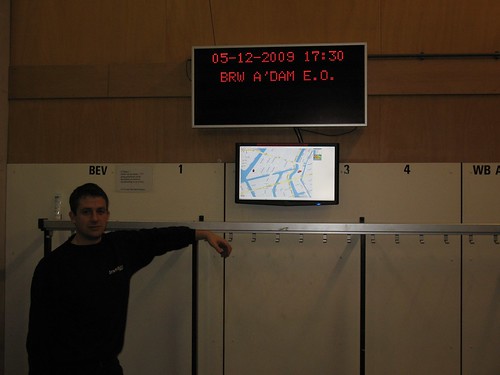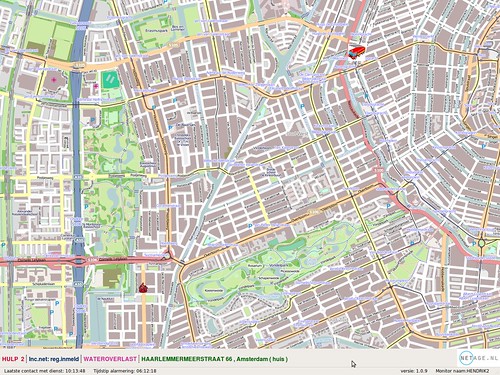The following guest post is from Bart van Leeuwen, a firefighter in the city of Amsterdam who has been experimenting with governmental linked data on Open Street Map to help improve fire truck navigation.
Working as a firefighter in the city of Amsterdam, will Linked Open Government Data help me fight fires? Probably not, but during the development of an innovative new way of assisting fire truck navigation, I found out that Linked Open Data could at least assist us getting to incidents easier and faster. One valuable addition for us is to plot the location where work is done on the city infrastructure, e.g. roadblocks. We do not maintain this information ourselves, so we went out to the department supplying this information.

Demanding other government departments to open up their data to us is a pretty tough job if there is no municipal wide policy on opening data. Of course, the questions the fire department asks are very well understood, and there is a great will to assist us but people still have cold feet on this issue. What could others do with it, are we allowed to do this, what are the risks etc.
We decided to go the other way around, in the talks we had with other departments we already noticed that they were also interested in information we could supply. This led to the initiative of publishing structured data related to incidents which is out on the web unstructured already. This way our department is giving a good example and we have a better position in demanding open data from others. A very interesting side effect is that even in our own organisation people start to think about opening up information for the organisation a whole. For example information that was locked up in excel sheets now is included in the solution I created. Even though we have no official policy, funding or projectplan it already has started!
Traditionally government organizations are slow in adopting change, getting LOD done on policy level alone can take a while, starting it from the work floor up, can speed up policy talks. Role up your sleeves and get your own data out there!

This post is by a guest poster. If you would like to write something for the Open Knowledge Foundation blog, please see the submissions page.









This looks like a good start to a blog but lacks context.
If this is for a technical audience, where are links to the data (SPARQL endpoint, CKAN packages, etc?) so we can have a look at it? Can we learn more about how OpenStreetmap data is being re-used?
If this is for a policy audience, can we learn more about how other departments can be convinced to collaborate, where the cost savings or efficiency gains in publishing structured data are, etc?
The way I read it Jo it’s pretty clear from this posting: start small, experiment, to convince other departments walk your own talk (share data to demand data), and the gain for the FD in this example is in faster approach times, which translates into lives saved.
@Jo, @Ton … yes I think it’s just some ambiguity in the post’s title. Calling something ‘getting started with…’ raises the expectation that it will provide links and starting points and a guide. In this case, the post is more a (great) little case study on ‘How we got started with…’.
@Jo, @Ton … yes I think it’s just some ambiguity in the post’s title. Calling something ‘getting started with…’ raises the expectation that it will provide links and starting points and a guide. In this case, the post is more a (great) little case study on ‘How we got started with…’.
@jo I’m not a blogger nor a tweeter, My intention was to show that by starting small you can already achieve big steps. Being part a of a mid size governmental organization I know from experience that trying to achieve innovative changes through policy is almost always a dead end. Now that I’ve started small and a clear benefit is shown policy makers start to understand the benefit. This clearly speeds up the process. I’ll take you comments and try to have my next post be a bit more head/body/tail compliant !!
Bart,
I strongly encourage you to get yourself a WebID (personal URI). A lot of people have been trying to contact you without success post Semtech 2010. Here are some WebID services:
http://id.myopenlink.net/ods — create an account, edit your profile, and your done
http://foaf.me — ditto .
Kingsley
Bart,
I’m smitten by this post. It highlights the problem with data stove pipes. It presents a viable solution that can be implemented with low overhead. It affirms that openness creates more of itself. It advocates starting with something simple that can function in an existing framework rather than starting with new policy.
Can you point me to more detail about your process and product for this:
“the initiative of publishing structured data related to incidents which is out on the web unstructured already.”
Is it manual or automated? Is it much of a maintenance burden? Who is responsible for maintenance? What does the structure look like after you’ve published it?
Many Thanks and Best Regards,
Kevin Curry
Virginia Beach, VA